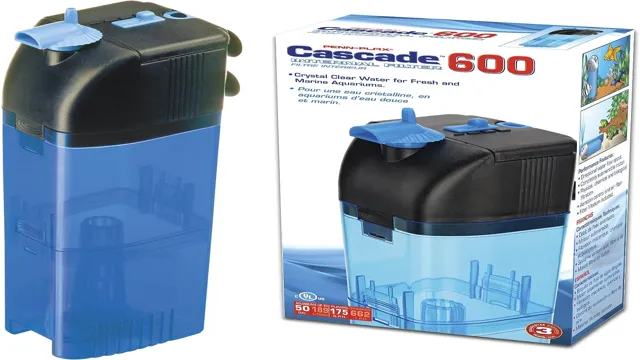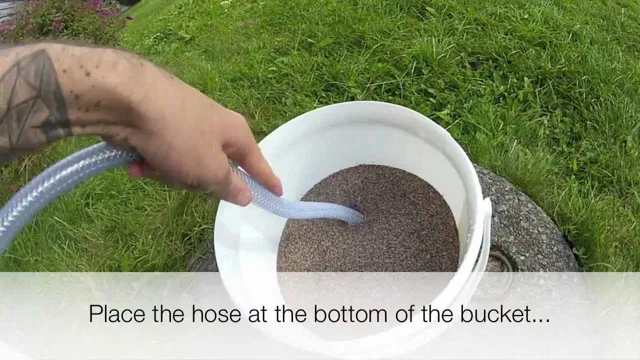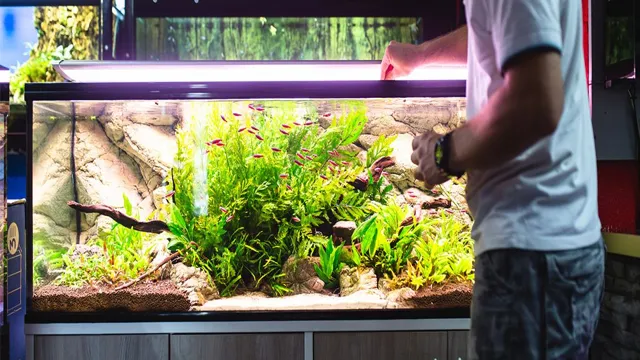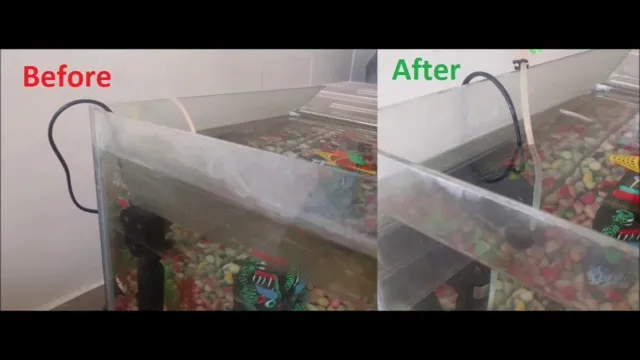Do you love having an aquarium at home, but hate the sight of your internal filter ruining the whole aesthetic? If so, you’re not alone. Aquarium filters are important to maintain the water and keep your aquatic inhabitants healthy, but they can be an eyesore. Fortunately, there are several creative and effective ways to hide your internal aquarium filter without sacrificing its functionality.
In this blog post, we’ll explore some brilliant ideas that will help you make your filter blend in seamlessly with your aquarium’s décor, making it a focal point for all the right reasons. So, let’s dive in!
Introduction
Is your internal aquarium filter ruining the aesthetics of your tank, but you don’t know how to hide it? Well, you’re in luck because there are several ways that you can conceal your filter without affecting its functionality. One practical solution is to use aquarium plants to hide your filter. You can choose from different types of aquatic plants, such as the java fern, anubias, or moss.
These plants not only enhance the overall appearance of the aquarium, but they also provide added benefits by removing nitrates and other pollutants from the water, which positively impacts the environment for your fish. Alternatively, you can hide your filter behind aquarium decorations such as rocks, caves, or driftwood. This way, your filter remains functional and concealed behind a natural-looking decor.
Remember, a healthy aquarium environment is pivotal for the health of your fish, so it is imperative to maintain regular filter maintenance and cleanings. By hiding your filter, you can create a visually appealing and healthy environment for your aquatic pets.
Explanation of why hiding the filter is important
When it comes to e-commerce websites, providing a seamless user experience is crucial in keeping customers happy and engaged. One important aspect of this is the filter function that allows users to easily narrow down their search results based on their preferences. However, some websites make the mistake of leaving the filter visible at all times, which can actually create an overwhelming and cluttered interface.
This is why hiding the filter until the user actively searches for it is so important. By doing so, the user has a cleaner and more streamlined view of the products available, allowing them to focus on what they are really interested in. Overall, keeping the filter hidden until needed is a small but effective way to improve the user experience and keep customers coming back.

Hiding Options
If you’ve set up an aquarium, you’re probably aware of the different types of filters available. Most aquarium filters are bulky and visible, which can detract from the aesthetics of your tank. However, you can hide an internal aquarium filter with a bit of creativity.
First, you can use decorative aquarium rocks or plants to camouflage the filter intake. Simply place the decor in front of the filter, making sure it doesn’t impede water flow. Another option is to place the filter in a discreet corner of the tank where it is less visible.
Be sure to position it appropriately, so it doesn’t disrupt the flow of water. Additionally, you can use aquarium cabinets or stands to conceal the filter entirely. These stands are designed to hold the aquarium and provide additional storage space, making them a practical and elegant solution for hiding the filter.
With a little ingenuity, you can effectively hide your internal aquarium filter and enjoy a more aesthetically pleasing aquarium.
Using aquarium plants
When it comes to hiding options in an aquarium, using aquarium plants is a great choice. Not only do they provide natural and beautiful scenery, but they also improve the water quality by absorbing carbon dioxide and releasing oxygen. There are many species of plants to choose from, such as Java Moss, Anubias, and Hornwort, which can either be attached to rocks or driftwood or weighted down in the substrate.
Performing regular maintenance, such as pruning and removing dead leaves, is important to keep them healthy and prevent them from overtaking the tank. With the right kind of lighting and water conditions, aquarium plants can thrive and create a lush, attractive environment for your aquatic pets to thrive in. So if you’re looking for a way to enhance your aquarium’s appearance and functionality, aquarium plants are definitely worth considering.
Blending the filter with aquarium decor
When it comes to creating a visually stunning aquarium display, the filter can sometimes be an eyesore. If you’re looking for ways to blend your filter with your aquarium decor, one option is to use decorations to hide it. There are plenty of hiding options available, from artificial plants to rock formations and driftwood.
These decorations not only help to disguise your filter but also add to the natural look of your aquarium. When choosing your hiding options, it’s important to consider the size of your filter and the space you have available in your aquarium. You want to choose a decoration that will sufficiently cover your filter but not overcrowd the tank. (See Also: How to Make a Mini Aquarium at Home: Step-by-Step Guide for Beginners)
With a little creativity and some careful planning, you can easily disguise your filter while still maintaining the overall aesthetic of your aquarium.
Covering the filter with a casing
When it comes to hiding your filter, the options are endless. Some people choose to hide it in a cabinet or behind a decorative screen, but another popular option is to encase it in a sleek and stylish cover. This not only hides the filter from plain sight, but it can also add an aesthetic touch to your room.
There are many different materials you can use to create a cover, including wood, metal, or even fabric. For a more rustic look, you could use reclaimed wood to create a cover that blends in with the rest of your décor. On the other hand, if you want a more modern look, you could choose a metallic cover that adds a sleek and minimalist touch to your space.
Whatever material you choose, make sure it is breathable, so that the filter can do its job properly. With so many options available, you can easily create a cover that complements your style and hides your filter in plain sight. So why not give it a try and take your room’s décor to the next level?
Step-by-Step Guide
If you’re looking for a way to hide your aquarium filter, don’t worry – it’s easy to do! Here are the steps to follow: First, choose a hiding spot. This could be behind some plants or decorations, or under some rocks or driftwood. Next, you’ll need to create a barrier between the filter and the viewing area of your aquarium.
This can be done using decorations or plants, or by attaching an opaque background material to the back of the tank. Once you have the hiding spot and barrier set up, you can place your filter in the hiding spot. Be sure to securely attach it so it doesn’t shift or fall over.
Finally, adjust the placement of any decorations or plants as needed to fully cover the filter. And that’s it – your filter is now hidden from view! With a little creativity, you can make it look like your aquarium has no filter at all.
Gathering materials needed
When it comes to gathering materials needed for a project, it’s important to take a step-by-step approach. First, take a closer look at the project and make a list of all the materials you’ll need to complete it. Consider the size of the project and any specific requirements or instructions that you need to follow.
This will help ensure that you have everything you need before you get started. Once you have your list, it’s time to start gathering the materials themselves. Depending on the project, this might involve a trip to the hardware store, craft store, or even your own basement or garage.
Make sure to consider things like quantity, quality, and price as you make your choices, and don’t be afraid to ask for help from a sales associate or online community if you need it. With the right materials and a little bit of time and effort, you can bring your project to life and create something truly special.
Preparing the filter and the casing
Preparing the filter and the casing is an important step in setting up a filtration system. First, select a filter that is appropriate for the type of water being filtered, such as a carbon filter for taste and odor removal or a sediment filter for removing particles. Once the filter is chosen, rinse it with water before installing it in the casing to remove any debris or dust.
Check the manufacturer’s instructions to see how the filter should be oriented, and make sure the sealing gasket is properly placed. Next, prepare the casing by cleaning it with warm soapy water and rinsing thoroughly. Lubricate any O-rings or gaskets with silicone grease to ensure a tight seal.
Once the filter and casing are prepared, it’s time to assemble and install the filtration system, following the manufacturer’s instructions carefully. By taking the time to properly prepare the filter and casing, you can ensure optimal performance and longevity of your filtration system.
Installing the casing onto the filter
Installing the casing onto the filter may seem like a daunting task, but with our step-by-step guide, it’s easier than you might think. First, make sure you have all the necessary equipment, including the casing, filter insert, and any necessary screws or clips. Next, insert the filter into the casing, making sure it fits securely and snugly.
Use screws or clips to hold it in place if necessary. Once the filter is securely in place, it’s time to install the casing onto your device. Carefully line up the casing with the holes or clips on your device and gently push it into place. (See Also: How to Cycle Your Aquarium Faster: Tips and Tricks for Speeding Up the Process)
Make sure it’s securely attached before moving on to the next step. Once the casing is attached, double-check everything is lined up correctly and there are no loose parts before turning on your device. With these simple steps and a little practice, you’ll be a pro at installing casings onto filters in no time.
Fitting the newly covered filter back into the aquarium
Once you have properly cleaned and covered your aquarium filter, the next step is to fit it back into your aquarium. This can be a bit tricky, but with our step-by-step guide, you should have no problem getting it done. First, carefully lower the filter into the water, being sure to avoid splashing or bumping any of your aquatic creatures.
Once the filter is submerged, slowly release it from your grip and let it settle at the bottom of the tank. Next, you’ll need to secure it in place. Depending on the type of filter you have, this could involve suction cups or brackets.
If using suction cups, simply press them firmly onto the aquarium glass and attach the filter. If using brackets, line them up with the filter and secure them in place with screws or bolts. Once your filter is securely attached, turn it on and watch as it begins to clean and circulate the water.
You may want to do a quick check to make sure that the water flow is not too strong for your aquatic inhabitants, as this can cause stress and discomfort. Once everything looks good, sit back and enjoy your crystal-clear, healthy aquarium! Remember, regular filter maintenance is key to keeping your aquarium in tip-top shape.
Maintenance and Troubleshooting
If you want to hide your internal aquarium filter, there are a few options you can consider. One option is to simply place decorations over the filter to camouflage it. This can include rocks, plants, or driftwood.
Make sure the decorations you choose don’t impede the flow of water or interfere with the filter’s operation. Another option is to purchase a filter cover that is designed specifically for your filter model. These covers can completely enclose the filter and come in various colors and designs to match your aquarium decor.
Lastly, you can also consider relocating the filter, either inside a cabinet or tucked away into a corner of the tank that is less visible. No matter which option you choose, make sure to periodically check and clean the filter to ensure it is functioning properly and not obstructed. By hiding your internal aquarium filter, you can create a more natural and aesthetically pleasing environment for your fish to thrive in without sacrificing functionality.
Cleaning the filter
Cleaning the filter is an essential part of maintaining your appliance’s longevity and performance. Over time, filters can become clogged with debris, reducing airflow and causing the system to work harder than necessary, which can eventually lead to a breakdown. When it comes to cleaning the filter, the process will vary depending on the type of appliance you have.
For example, air conditioners may have washable filters that can be rinsed under running water, while some vacuum cleaners will require a replacement filter to be purchased. Before attempting to clean the filter, make sure to consult your appliance’s manual for specific instructions on how to do so. In general, though, it’s a good idea to clean or check your filter at least once a month, especially if you use your appliance frequently.
Not only will it help keep the air in your home clean, but it can also save you money on electricity bills in the long run. By taking the time to clean your filter regularly, you can extend the life of your appliance and ensure that it runs efficiently.
Preventing overheating and other filter issues
One of the most critical aspects of maintaining your filter system is preventing overheating. Overheating can lead to a host of issues, including damage to the motor and fire hazards. To prevent overheating, ensure that your filter system is installed in a well-ventilated area and that there is enough space around the unit for proper airflow.
Additionally, regularly cleaning the filter and ensuring that it’s not clogged with debris can prevent overheating and improve the overall efficiency of the system. If your system does overheat, it’s important to turn it off immediately and contact a professional for repairs. Other common filter issues include leaks, strange noises, and a reduction in performance.
If you notice any of these issues, it’s crucial to address them promptly to prevent further damage and ensure that your system operates effectively. Regular maintenance and troubleshooting can help prolong the life of your filter system and prevent costly repairs down the road. (See Also: How to Create a Brackish Water Aquarium: A Step-by-Step Guide for Beginners)
Conclusion
In conclusion, hiding an internal aquarium filter may seem like an unachievable feat, but with a little creativity and some clever placement, it is definitely possible. Whether you opt for plants, rocks, or even a well-placed ornament, the key is to think outside of the box and use your imagination. So remember, when it comes to hiding your aquarium filter, with a little bit of effort and some sneaky camouflage, you’ll have your fish tank looking picture perfect in no time!”
Summary of benefits of hiding the filter
When you hide the filter of your HVAC system, it can greatly benefit maintenance and troubleshooting. HVAC filters require regular maintenance and occasional replacement, and when they’re hidden away, they can be easy to forget about. By hiding the filter, it becomes less of a visual distraction and can encourage those responsible for maintenance to remember to carry out this important task.
Troubleshooting can also be improved by hiding the filter. If the filter is easily accessible, it may be touched or moved by those who are not qualified to do so, potentially causing more harm than good. By hiding the filter, it reduces the chance of accidental misplacement or damage.
Additionally, concealing the filter can also improve the overall appearance of the system, making it less of an eyesore and allowing it to blend in more seamlessly with its surroundings. Ultimately, hiding the filter can improve the longevity of the HVAC system and reduce the likelihood of maintenance issues.
FAQs
What is an internal aquarium filter?
An internal aquarium filter is a type of fish tank filter that is placed inside the tank, typically in a corner or against the back wall.
Why would someone want to hide their internal aquarium filter?
Some aquarium owners choose to hide their internal aquarium filter to create a more natural and aesthetically pleasing look for their tank. Additionally, hiding the filter can prevent distractions or disturbances for fish and other aquatic species.
What are some ways to hide an internal aquarium filter?
One way to hide an internal aquarium filter is to place plants or decorations around the filter to camouflage it. Another option is to build a custom cover or housing for the filter that blends in with the tank’s decor.
Can you completely hide an internal aquarium filter?
While it may be difficult to completely hide an internal aquarium filter, creative placement and decor can make it nearly invisible. However, it is important to ensure that the filter remains accessible for maintenance and cleaning.
Are there any drawbacks to hiding an internal aquarium filter?
Hiding an internal aquarium filter may make it more difficult to monitor its performance and clean it when necessary. Additionally, certain types of decorations or materials used to conceal the filter may impact water quality or create an unsafe environment for fish and other aquatic species.
What should you consider before attempting to hide your internal aquarium filter?
Before attempting to hide an internal aquarium filter, it is important to consider the specific needs of your fish and aquatic species, as well as the type and size of filter you are working with. You should also research safe materials and methods for concealing the filter and ensure that it remains accessible for maintenance and cleaning.
Can you use external aquarium filters instead of internal filters to make them easier to hide?
Yes, external aquarium filters can be easier to hide than internal filters since they are placed outside the tank. However, they may be more expensive and require additional equipment and setup. Additionally, external filters may not be suitable for all tank sizes or types of aquatic species.







